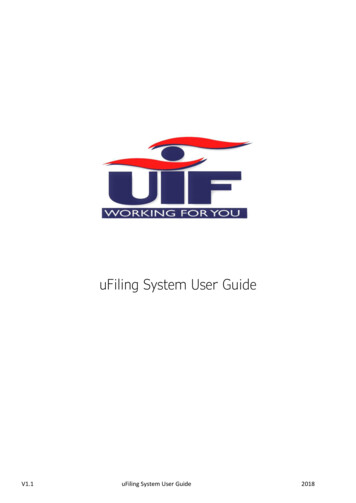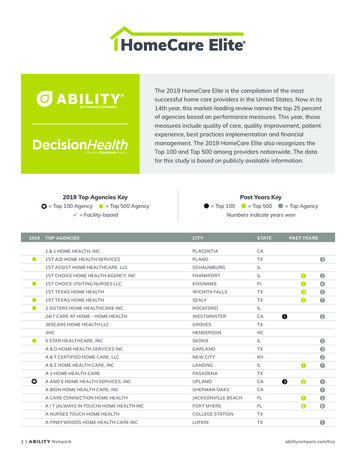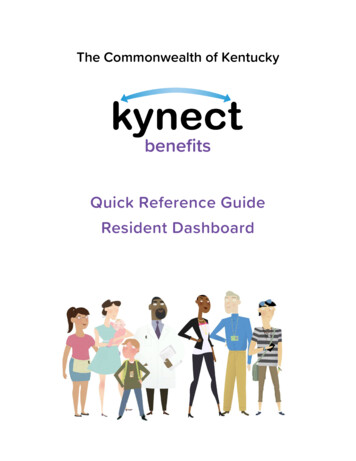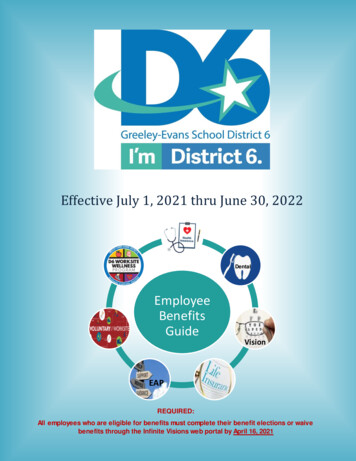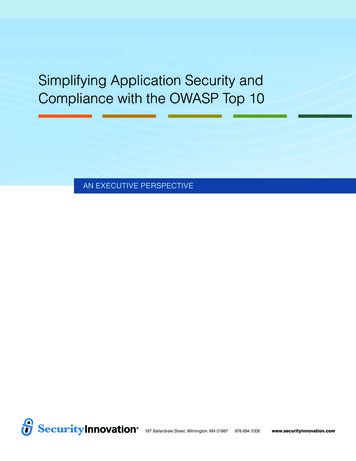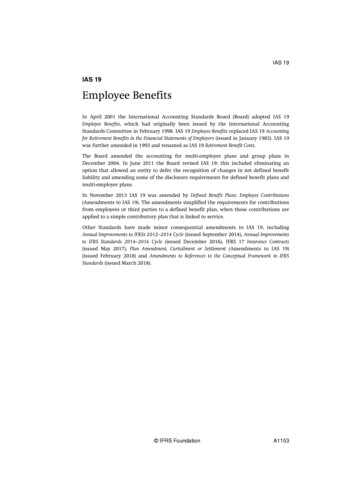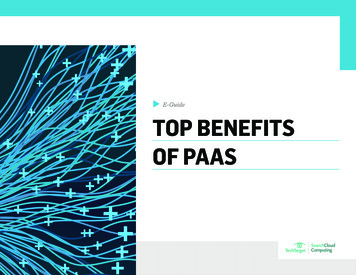
Transcription
E-GuideTOP BENEFITSOF PAASSearchCloudComputing
TOP BENEFITS OF PAASHomeIf IT had a hammer:Choosing amongIaaS, PaaS and SaaSEWhen IaaS won’t cutit: Planning atransition to PaaScloudnterprises tend to use the latest technol-ogy to solve all of its IT problems. But ifyour apps are nails, is IaaS, PaaS or SaaSreally the hammer? In this e-guide, learnhow PaaS can most often fully meet the needs of most cloud applications, and also tips for considering cloud management for anIaaS-to-PaaS switch.PA G E 2 O F 1 1SPONSORED BY
TOP BENEFITS OF PAASIF IT HAD A HAMMER: CHOOSING AMONG IAAS, PAAS ANDSAASHomeIf IT had a hammer:Choosing amongIaaS, PaaS and SaaSWhen IaaS won’t cutit: Planning atransition to PaaScloudThere is a tendency in the technology world to assume we should use the latestinnovation to solve all problems. We often express this by paraphrasing the lawof Maslow’s Hammer: “If you are holding a hammer, every problem looks likea nail.” Cloud computing is no exception; everything is going to the cloud -- orso we are told.To follow the metaphor, whichever piece of the cloud the vendor has provided becomes the hammer, and all of a company’s workloads and applicationsbecome the nails. The question is which distribution model -- IaaS, PaaS orSaaS -- is right for your needs.Software as a Service (SaaS) is the classic “make versus buy” decision; ifyou can buy a service that meets the majority of your needs then that is the mosteconomical flavor of cloud. But don’t let the fear of building an application pushyou into buying something that does not fit your business needs. Your businessprocesses are your fundamental differentiators in the market, so don’t compromise them to fit an off-the-shelf option.PA G E 3 O F 1 1SPONSORED BY
TOP BENEFITS OF PAASHomeIf IT had a hammer:Choosing amongIaaS, PaaS and SaaSWhen IaaS won’t cutit: Planning atransition to PaaScloudIf after evaluating off-the-shelf options you decide your needs are best metwith a custom-built application, the next step is to determine if you need thecloud. Is your problem a problem of scale? If not, there may be more economical ways of solving it. If so, cloud is the best option, as long as the governmentor some other external agency doesn’t create regulatory or compliance issuesthat stand in your way.Having concluded that the cloud is the best approach for your custom-builtapplication, conventional wisdom from cloud vendors presents you with a falsedichotomy: You must choose Platform as a Service (PaaS) or Infrastructure asa Service (IaaS). It’s clear why cloud vendors would present this choice, but ifwe look closely, we see that for customers it does not hold up.Of the three scaling scenarios -- transactions, data and geography -- youcan immediately factor out data and geography, as the storage capabilities ofPaaS offerings are either identical to Google App Engine or Windows Azureor reliant on Heroku, Cloudbees, etc. -- the IaaS layer. Also, geographic distribution is fundamental to cloud services. The choice needs to be made on theexecution resources, which is consistent with this being a software applicationimplementation.But PaaS offerings like Windows Azure do have a value trade. The developerPA G E 4 O F 1 1SPONSORED BY
TOP BENEFITS OF PAASHomeIf IT had a hammer:Choosing amongIaaS, PaaS and SaaSWhen IaaS won’t cutit: Planning atransition to PaaScloudgains freedom from low-value administrative functions and gives up somefine-grained control of the environment. A PaaS developer works within anenvironment that is defined by the service. While a product may have involveda change to the underlying environment, that approach is not available in PaaS.The economic value of PaaS comes from not having to create infrastructureimages during the design phase and therefore not having to maintain them inproduction.With an open mind, PaaS can fully meet the needs of most cloud applications. However, there are scenarios in which running an app in PaaS is just tooconvoluted to make practical sense. For these scenarios, IaaS generally fills theneed. This decision must be made very carefully though, because there is a definite economic impact. In effect it offers the opposite value trade: The developergains fine-grained control of the environment in exchange for accepting theresponsibility for building and managing the environment. That responsibilitycomes with time-to-market implications at design time and ongoing cost in themaintenance and operations realm.So how much PaaS is right? To paraphrase Einstein: You should use asmuch PaaS as possible, but no more.PA G E 5 O F 1 1SPONSORED BY
TOP BENEFITS OF PAASWHEN IAAS WON’T CUT IT: PLANNING A TRANSITION TOPAAS CLOUDHomeIf IT had a hammer:Choosing amongIaaS, PaaS and SaaSWhen IaaS won’t cutit: Planning atransition to PaaScloudWhile nearly all cloud users begin with Infrastructure as a Service (IaaS), manywho run most applications on the same OS and middleware later decide thatPlatform as a Service (PaaS) would better serve their needs. PaaS cloud offersusers who have a commitment to a single operating system and middlewarelower software licensing and operations costs because the cloud platform absorbs these components.Users who have made the IaaS-to-PaaS cloud switch report it requiresplanning in three areas: OS and middleware compatibility, deployment andintegration practices, and operations and management. Users also suggest thatall cloud prospects look at IaaS-to-PaaS migration very early in their planning,even before they’re sure they’ll make the switch. Finally, these early users saythat often the only alternative to a transition in cloud service type is to embracea multiprovider cloud, something that can be even more daunting than switching from one cloud platform to another.PA G E 6 O F 1 1SPONSORED BY
TOP BENEFITS OF PAASCHOOSING IAAS AND PAAS PROVIDERSHomeIf IT had a hammer:Choosing amongIaaS, PaaS and SaaSWhen IaaS won’t cutit: Planning atransition to PaaScloudIaaS is generally tolerant of middleware choices; anything you can composeinto a machine image will run. Some IaaS cloud providers may limit operatingsystem choices, or at least require slightly different management or deployment options depending on the OS you pick. PaaS, in contrast, will generallydictate the OS and much of the middleware. For users who want to preservethe option of migrating to PaaS, it’s critical to choose the PaaS cloud providerfirst and select the IaaS OS and middleware software based on that selection.Otherwise it may be impossible to migrate from IaaS to PaaS without rewritingor re-licensing software for the PaaS platform you choose.Most PaaS cloud providers will offer an IaaS mode, which means that their“platforms” will run virtual machines that can host other OSes and middleware. This is true of Microsoft’s Windows Azure, for example. It may makesense to select a PaaS provider that can run IaaS, but be aware that you can stillrun OSes and middleware in the IaaS “containers” of a PaaS provider that won’trun in PaaS mode on that same provider. The hosted-IaaS model will save yousome headaches changing providers and may reduce deployment and operations differences in your transition, but it has its own frustrations.PA G E 7 O F 1 1SPONSORED BY
TOP BENEFITS OF PAASCONSIDERING CLOUD MANAGEMENT FOR AN IAAS-TO-PAAS SWITCHHomeIf IT had a hammer:Choosing amongIaaS, PaaS and SaaSWhen IaaS won’t cutit: Planning atransition to PaaScloudCloud-based application deployment and integration is a matter of exercisingthe cloud’s management interfaces. These interfaces vary, even among IaaSproviders, which means deployment/integration tools and practices will haveto change when transitioning from IaaS to PaaS.In preliminary cloud planning, look for tools that support both IaaS andPaaS providers, but expect to make some changes in the deployment and integration scripts when you make the transition. Commercial tools may be moreaccommodating than open source tools because most PaaS platforms use proprietary OS and/or middleware, and many open source products haven’t beenupdated to accommodate these kinds of choices.The long-term management of cloud applications is almost certain to bedifferent for PaaS versus IaaS, primarily because management of the OS andmost of the middleware becomes the responsibility of the cloud provider underPaaS. Enterprises will not have to update these components, but they may stillwant to perform some regression testing when a major change in PaaS software is scheduled. This means that operations and management will have tobe changed to eliminate tasks related to updates and upgrades to the platformsoftware, but also that application lifecycle management tasks may requirePA G E 8 O F 1 1SPONSORED BY
TOP BENEFITS OF PAASHomeIf IT had a hammer:Choosing amongIaaS, PaaS and SaaSWhen IaaS won’t cutit: Planning atransition to PaaScloudsome external coordination with the cloud provider to facilitate testing and acutover to a new software version.PaaS may offer unexpected benefits in both deployment and operations/management tasks, because most companies select a PaaS based on the platform that is already standardized on most of their internal servers. In this case,the same tools will be useful in deployment and management of PaaS applications as were used in the data center, and some PaaS providers will also provide special tools for hybrid cloud integration between data center and PaaSclouds. It’s also often possible to create hybrid cloud applications to provideimproved performance and availability by offering easy “cloud bursting” fromthe data center to PaaS. This same capability can be provided in IaaS, but theywill almost always require more integration work from the user -- and often achange in software as well.WHEN MIGRATION DOESN’T WORKNo matter how much you prepare for an IaaS-to-PaaS migration, there will betimes when it just can’t be made to work. In most cases, that’s because an application being run on IaaS isn’t compatible at the software platform level withyour PaaS selection -- or even with “IaaS-container” facilities of the new PaaSPA G E 9 O F 1 1SPONSORED BY
TOP BENEFITS OF PAASHomeIf IT had a hammer:Choosing amongIaaS, PaaS and SaaSWhen IaaS won’t cutit: Planning atransition to PaaScloudprovider. In this case, you must accept choosing among three options: Find aversion of the same application(s) for the PaaS platform, drop the offendingapplication(s) from the cloud or, finally, embrace using multiple public cloudproviders.If packaged software is used, the first option is the best where it’s available;check your software supplier for a list of the OSes and middleware it can support and see if your license will cover the new configuration, even at an extracost. If only a few applications are incompatible with a PaaS migration, it maybe reasonable to host them internally. When none of this works, multiple providers is the fall-back option.One user described using multiple cloud providers as “the gift that keeps ontaking” because the problems with deployment, integration and management/operations tend to be ongoing when multiple providers are involved. Most userswill consider this their last resort for that reason; so when it’s truly necessary tomake the choice, look hard at the deployment and management tools availableand pick the packages with the broadest support for a variety of cloud providers.PA G E 1 0 O F 1 1SPONSORED BY
TOP BENEFITS OF PAASFREE RESOURCES FOR TECHNOLOGY PROFESSIONALSHomeIf IT had a hammer:Choosing amongIaaS, PaaS and SaaSWhen IaaS won’t cutit: Planning atransition to PaaScloudTechTarget publishes targeted technology media that addressyour need for information and resources for researching products, developing strategy and making cost-effective purchasedecisions. Our network of technology-specific Web sites givesyou access to industry experts, independent content and analysis and the Web’s largest library of vendor-provided white papers, webcasts, podcasts, videos, virtual trade shows, researchreports and more —drawing on the rich R&D resources of technology providers to addressmarket trends, challenges and solutions. Our live events and virtual seminars give you access to vendor neutral, expert commentary and advice on the issues and challenges youface daily. Our social community IT Knowledge Exchange allows you to share real worldinformation in real time with peers and experts.WHAT MAKES TECHTARGET UNIQUE?TechTarget is squarely focused on the enterprise IT space. Our team of editors and network of industry experts provide the richest, most relevant content to IT professionals andmanagement. We leverage the immediacy of the Web, the networking and face-to-face opportunities of events and virtual events, and the ability to interact with peers—all to createcompelling and actionable information for enterprise IT professionals across all industriesand markets.PA G E 1 1 O F 1 1SPONSORED BY
TOP EEFITS OF PAAS. CHOOSING IAAS AND PAAS PROVIDERS. IaaS is generally tolerant of middleware choices; anything you can compose into a machine image will run. Some IaaS cloud providers may limit operating system choices, or at least require slightly different management or deploy-ment options depending on the OS you pick.

